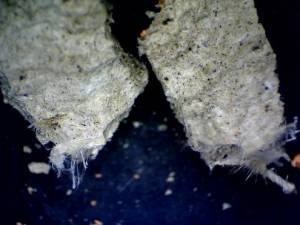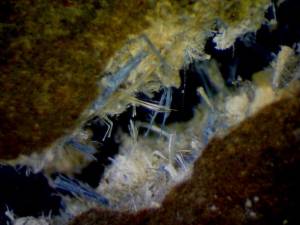Asbestos cement is mostly used for roofing and exterior cladding on industrial, public, and domestic premises. Corrugated/profile sheets are commonly found, but flat sheets have also been widely used for exterior and some interior cladding.
Cement materials tend to deteriorate through carbonation leading to embrittlement (associated loss of strength) (Ingham et al 2012). Surface deterioration of cement products also can happen due to abrasion or persistent damp conditions that are aided by organic growth (Ministry of Health. 2017). These factors would contribute asbestos materials to soils. However, the most likely cause of soil contamination is demolition, upgrade of buildings, or disposal of asbestos wastes before asbestos disposal control was put into effect in New Zealand.
The risk of exposure is when the cement materials degrade and become friable. This causes the asbestos materials to break down and crumble, releasing tiny asbestos particles into the ambient atmosphere (Kidd S, 2020).
Challenges are often faced in quantitatively reporting the correct approximate percentage of asbestos in cement materials. Analysts at Focus Analytics use HSG 264:2012 as a referencing guide to determine the concentration of asbestos present in types of cement and other asbestos-containing materials. HSG 264:2012 categorizes cement asbestos concentration as (profiled sheet and performed molded products 10 – 15%, semi compressed flat profile 10 -25% (figure 1.1) and fully compressed as (50%) chrysotile and other amphiboles. Thus, for reporting purposes, a conservative approach is used. The higher percentages of respective cement materials are selected for the determination of asbestos present in the bonded cement sample.
Figure 1 Cement comprising of Chrysotile and Amosite (Focus Analytics:2020)
However, there is always a discussion on the percentage of asbestos found in cement products in New Zealand. For e. g. more than 50 % of asbestos can be visually inspected in older cement products which contain all the three types of asbestos; Chrysotile, Amosite, and Crocidolite (Figure 2). (Ministry of Health. 2017.) mentions that older types of cement from the 1950s contained crocidolite with a percentage of asbestos up to 50.
Figure 2 Cement containing Chrysotile, Amosite, and Crocidolite (Focus Analytics:2020)
Historically in New Zealand from the 1920s to the 1980s asbestos was a widely used material in product manufacture (Hunt et al., 2017). Until the early 1950s, most asbestos cement produced and used in New Zealand contained crocidolite with an asbestos concentration of 50 % or higher. Common asbestos cement names included Durock, Durotherm, Harditherm, Fibrolite, Coverline (Ministry of Health 2017). After 1982 asbestos materials were slowly replaced with cellulose fibers as reinforcing material to cement.
Reference:
Hunt, S., Mechaelis, M., Dangerfield, D., & Bint, L. (2017). New Zealand Guidelines for Assessing and Managing Asbestos in Soil (1st ed., pp. 13-16). Print link, Petone.
Ingham, J. (2013). Concrete products. Geomaterials Under the Microscope, 121-127. https://doi.org/10.1016/b978-0-12-407230-5.50014-5
Kidd, S. (2020). Asbestos in Cement – Discover Where Asbestos was Located. Mesothelioma Justice Network Powered by Asbestos.net. Retrieved 29 September 2020, from https://www.asbestos.net/asbestos/products/cement/.
Ministry of Health. 2017. The Management of Asbestos in the Non-Occupational Environment: Guidelines for Public Health Units (5th edn). Wellington: Ministry of Health. Pg 13-15



